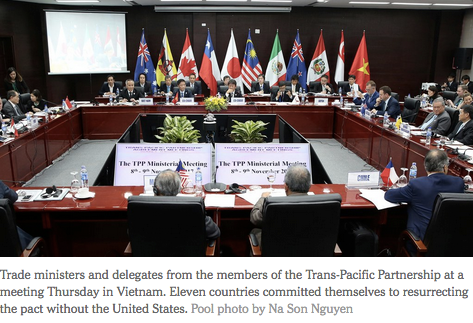HONG KONG — President Trump shook up the world economic order this year by pulling the United States out of a major international trade pact and raising fundamental questions about its global role.
Today, the world is moving on without it.
A group of 11 countries announced on Saturday that they had committed to resurrecting a sweeping multinational trade agreement, the Trans-Pacific Partnership, without the United States. A new deal, which would have to be signed and ratified by each country, would include major United States allies like Japan, Canada and Mexico. Collectively, they account for about a sixth of global trade.
The agreement will “serve as a foundation for building a broader free-trade area” across Asia, Taro Kono, Japan’s foreign minister, said in a statement.
Pointedly, the potential members of what is now called the Comprehensive and Progressive Agreement for Trans-Pacific Partnership came to an early agreement on the broad outline of a deal while many of their leaders were meeting with Mr. Trump in Vietnam — itself a potential member of the new trading group.
Some details of a new deal, including when rules would be phased in, still need to be determined, and prospective member states like Canada raised last-minute concerns. But a new deal could be announced as soon as early next year.
Other countries are slowly but surely making progress on their own sweeping trade deals, without any participation from the United States. China is negotiating a potential deal with 16 Asia-Pacific countries, including Japan, India and South Korea. The European Union and Japan hope to strike separate trade pacts with a group of South American countries, Brazil and Argentina among them.
From tough talk on China (“they took our jobs”) to casting doubt on the decades-old North American Free Trade Agreement (“the worst trade deal ever made”), Mr. Trump has threatened to lob a grenade at an increasingly integrated global economic system.
His administration has questioned years of efforts to lower global trade barriers, arguing that they hurt American workers and led to big trade deficits. It also means dealing with nations one-on-one, rejecting the regional and global pacts his predecessors pursued.
But other factors are pushing the rest of the world to fill the void left by the United States. China’s rise as a regional and economic power is driving other nations either to join with it or to join together to counter it. Fast development in places like Southeast Asia means potential new markets for all kinds of products. The absence of the United States means potential opportunities for others.




